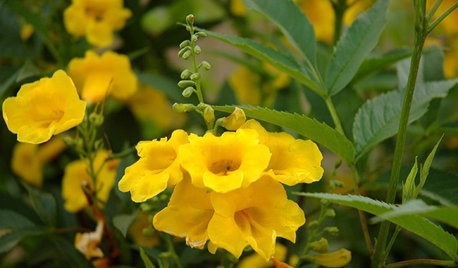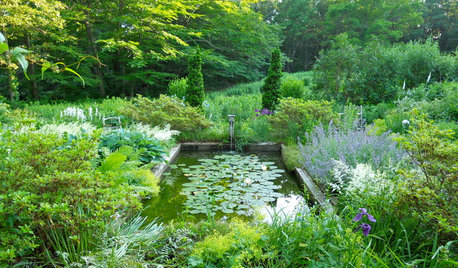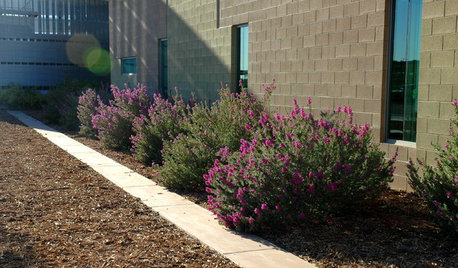Screening Trees and Large Shrubs
ejr2005
17 years ago
Featured Answer
Comments (33)
arbo_retum
17 years agolast modified: 9 years agoejr2005
17 years agolast modified: 9 years agoRelated Discussions
Designing a large mixed tree and shrub windbreak
Comments (23)Thanks everyone. digdig, you make a good point about spreading out the fall color. Many trees just go brown and that's it, but some, like liquidamber and birches have lovely fall color. Rico, sounds like it worked really well for you, congrats! Any chance you can post a photo? (I'm very visually oriented.) The terrain goes over a gentle hill lengthwise ( middle 50 feet), with dry, somewhat rocky soil in the middle, and good loam on either side. That alone will force different planting so I have happy trees on that dry bit. The other side will only be seen if you walk around it. It's not visible from the road or from the neighbors. There are no overhead wires. There are underground utilities that cut across one section. I plant to just plant across it. If they ever need to be dug up, fine. My understanding is that most tree and shrubs roots do not go deep and will not interfere with them 4 feet down. Alyrics, you bring up a good point that I have been debating. Should I just plant some trees and mulch around them 4 feet and do crazy mowing between all of them? Or should I try to do a complete kill of all the grass with roundup and mulch heavily with wood chips? I'm leaning towards the former because it's easier. Although in reality it will probably be weedy for years. Right now I have a small hill of woodchips that I got from the highway cleanup crews after our October surprise snowstorm last year. (2 large dumptrucks full) I'm usually able to get woodchips around here pretty cheaply, so the cost of the mulch won't be an issue, it's more the labor of placing them. Groundcover is out, that is definitely too much work. Any thoughts on the mulch versus mowing versus weeds? Thanks for all your input....See Morelarge screen shrubs for full sun border
Comments (16)Have you thought about Heavenly Bamboo (Nandina domestica)? I planted 3 of these on the front border of my property last fall so they aren't very tall yet, but are supposed to grow fast. Here is the plant info from Lowes (where I bought the plants): Plant Type: Shrub Sun Exposure: Full Sun Growth Rate: Fast Growth Average Height: 6-8' Cold Hardiness: -10 F Graceful upright evergreen. Young leaves coppery to purple red. Mature foliage is leathery, blue green with red tinit after first hard frost. Clusters of tiny white flowers appear May and June. Red berries in winter. Spacing: 3-4' Water Usage: Semi-Moist Pruning: Prune to keep compact Successful growing requires excellent drainage....See MoreScreening Tree/Shrub Advice Needed
Comments (11)I have to agree with T'John that part shade won't give the very rapid growth you want, so you may be out big bucks to get bigger trees to start with. The magnolia, unless you paid for big ones, would be slow growing, esp. in shade - they mostly like sun, so may not do well at all in mostly shade. The sweet bay, M. virginiana, does OK with shade. Height might be iffy too - you would have to pick a cultivar carefully. Again, you would have to chose carefully, since they are shrubby when young and might need limbing up, but a vibunum of one kind or other shouldn't get too tall, and will flower. I don't know about fall color. Redbud, a native, would do, maybe as a mix of the green-leaved and the purple-leaved-in-spring-and-early summer Forest Pansy, to give early spring flowers. Franklinia is another native possibility, and would give summer flowers, but might end up too tall. Davidia, while possibly hard to find, is another summer-flowering tree, and Carolina Silver Bell (also native) is another spring flowering. Service berry or Juneberry (Amelanchier) is another native with spring flowers. Mayhaw would give flowers and berries, and is another native. And one or another of the clumping bamboos might be a thought. Hope this list gives you a few to look up and think about....See MoreNeed screening tree/shrub suggestions
Comments (10)oakleafs grow at a decent clip, but i don't know how much the clay might slow them down. i planted mine in clay and it has tripled in size over about 5-7 yrs. was about 2' when i planted it- is about 6' all around now. i don't know what size the pot was, but it very well could have been 3 gallon. i haven't babied it at all- if you watered & or fertilized, the growth might be faster. nice flowers that persist. and remember, oafleafs are deciduous, so your screen will be bare come winter. i have a weeping yaupon in pretty heavy shade, and it's done well. i didn't plant it there, and in fact didn't know what it was for a long time. i think it must have been planted 20 yrs ago. there's a second one that's very stunted beside it. it's nice and dense and is about 10' tall. doesn't bloom or set as many berries in the sahde, but the form is still nice. althea(rose of sharon) can do ok in light shade and has the advantage of fast growth and nice blooms in a range of colors half the summer. disadvantage- it sets seeds. if you mulched well it might not be a problem. it's also deciduous. if you find someone who has them, they'd be happy to share, probably. i know i will if you want some. we had one that was about 15-20' in the backyard before fran came through. the remaining ones are about 12'. you might consider planting 2 or 3 types of plants in your space, just to vary it a bit, and so that if any one thing doesn't do well, the others can carry its weight. it tends to look a lot more natural, too. you can have your cake & eat it too if you have some evergreen & some deciduous back there. i would think for most things planting now would be just fine. good luck! tammy...See Moreprairiemoon2 z6b MA
17 years agolast modified: 9 years agoyork_rose
17 years agolast modified: 9 years agoejr2005
17 years agolast modified: 9 years agorunktrun
17 years agolast modified: 9 years agoego45
17 years agolast modified: 9 years agoejr2005
17 years agolast modified: 9 years agoego45
17 years agolast modified: 9 years agoprairiemoon2 z6b MA
17 years agolast modified: 9 years agodiggingthedirt
17 years agolast modified: 9 years agomad_gallica (z5 Eastern NY)
17 years agolast modified: 9 years agorunktrun
17 years agolast modified: 9 years agoarbo_retum
17 years agolast modified: 9 years agoyork_rose
17 years agolast modified: 9 years agoyork_rose
17 years agolast modified: 9 years agoWendyB 5A/MA
17 years agolast modified: 9 years agodiggingthedirt
17 years agolast modified: 9 years agoprairiemoon2 z6b MA
17 years agolast modified: 9 years agoego45
17 years agolast modified: 9 years agoprairiemoon2 z6b MA
17 years agolast modified: 9 years agoego45
17 years agolast modified: 9 years agoego45
17 years agolast modified: 9 years agoprairiemoon2 z6b MA
17 years agolast modified: 9 years agodiggingthedirt
17 years agolast modified: 9 years agoejr2005
17 years agolast modified: 9 years agoyork_rose
17 years agolast modified: 9 years agoyork_rose
17 years agolast modified: 9 years agodiggingthedirt
17 years agolast modified: 9 years agoego45
17 years agolast modified: 9 years agoejr2005
17 years agolast modified: 9 years agoprairiemoon2 z6b MA
17 years agolast modified: 9 years ago
Related Stories

TREESHow to Buy Healthy Trees and Shrubs
A healthy young plant with a strong form is more likely to do well in your yard. Here’s what to look for at the nursery
Full Story
GARDENING GUIDES8 Native Shrubs for Year-Round Bird Feeding
It’s not just about berries. These plants provide insects for birds and seasonal interest for gardeners
Full Story
GARDENING GUIDESHow to Prune Your Flowering Shrubs for the Best Blooms
Less is often more when it comes to properly pruning flowering shrubs. Here’s what to do and why
Full Story
GARDENING GUIDESGreat Design Plant: Yellow Bells, a Screening Queen
With its large size and copious golden flowers, this shrub can cover walls or screen unsightly views with ease
Full Story
GARDENING GUIDESGrow Your Own Privacy: How to Screen With Plants and Trees
Use living walls to lower your home and garden's exposure while boosting natural beauty in your landscape
Full Story
GARDENING GUIDESPrunus Virginiana Thrives Under Deciduous Trees
Plant chokecherry for showy white flowers favored by native bees in spring, and to provide nesting habitat and food for birds
Full Story
PLANTING IDEAS5 Reasons to Bring Shrubs Into the Flower Garden
Mix up the garden experience and let the flowers and shrubs play together
Full Story
GARDENING GUIDESHow to Avoid Overcrowded, Overpruned Shrubs
Go for a more natural look that’s easier and less expensive to maintain by giving your plants the right amount of growing room
Full Story
GARDENING GUIDES8 Deer-Resistant Elegant Evergreen Shrubs to Plant This Fall
Who knew that such beautiful shrubs could be deer-resistant?
Full Story
FALL GARDENING9 Deer-Resistant Flowering Shrubs to Plant This Fall
These exquisite shrubs will attract your attention but won’t tempt the deer that roam your neighborhood at night
Full Story







prairiemoon2 z6b MA